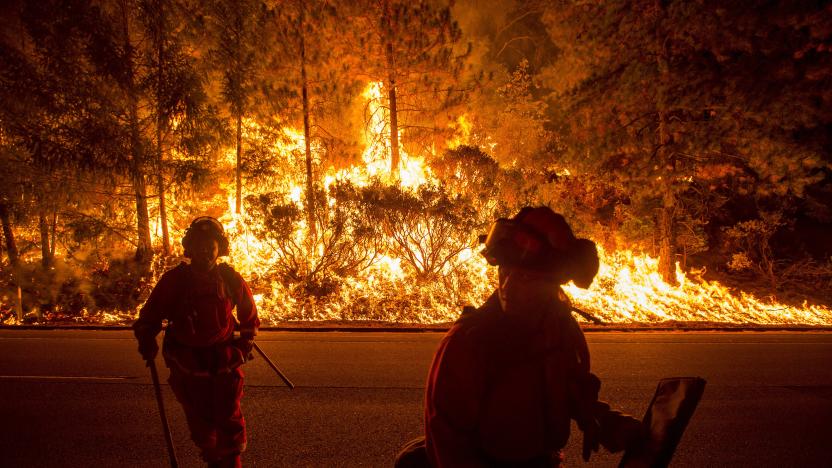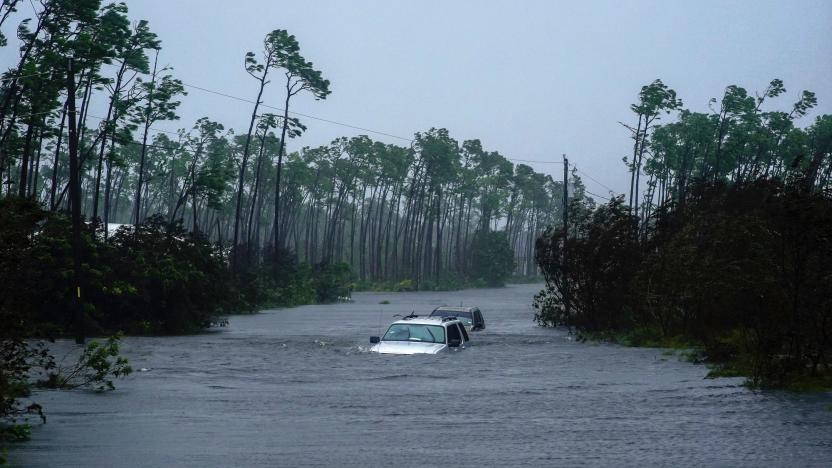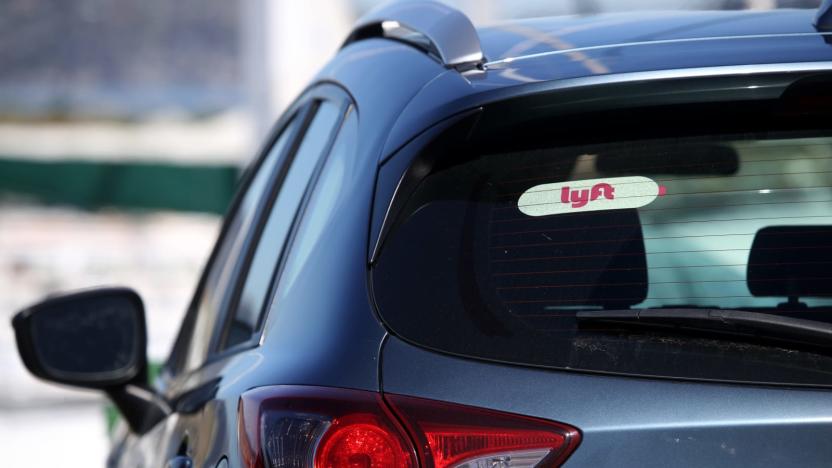natural disasters
Latest

Microsoft is helping the government build AI disaster response tools
Microsoft and the DOE are building AI disaster response tools.

Drone network provides early warnings for natural disasters
Drones might soon deliver a heads-up when natural disasters are about to strike. Researchers have developed a communication system that uses a drone network to provide early warnings for disasters. The challenge wasn't so much the drone-to-drone communication as the battery life. Where a typical hobbyist drone rarely lasts more than half an hour in the air, a smarter resource allocation method helps this system lasts three to five longer while covering a large area. The drones can also form a WiFi hotspot that keeps people online when conventional infrastructure has fallen apart.

GM will offer free OnStar crisis support during Hurricane Dorian
As Hurricane Dorian begins crawling towards Florida's coast, automakers are doing their part to help. GM announced today that they will offer free OnStar Crisis Assist services to all owners of properly equipped Chevrolet, Buick, GMC and Cadillac vehicles who live in the impacted region. The connected car platform can help those fleeing disasters with real-time directions, free calls, routing to shelter, food and water, providing an in-vehicle WiFi hot spot, booking hotel rooms and more.

Lyft outlines its disaster response strategy
Lyft just illustrated how it will respond in the middle of a crisis. The company has introduced a Disaster Relief Access Program that promises support for people in affected areas. In situations when the roads are safe, the ridesharing firm will typically hand out free codes both through its own social network avenues as well as local news outlets, non-profits and Facebook's Crisis Response Hub. It'll also honor emergency declarations that affect road closures and pricing, including caps on Prime Time (read: surge pricing).

EVE Evolved: Donate your old spaceships to charity
The Philippines recently suffered its worst natural disaster in living memory when typhoon Haiyan made landfall on November 8th, leaving over half a million people displaced and millions without food and basic supplies. Countries and organisations around the world have been sending relief aid into the region, and gamers have once again proven to be a generous bunch. Several livestreamers have been running donation drives; the developers behind Luvinia Online even promised to donate 100% of the income from three new in-game items to the Philippine Red Cross. EVE Online has now also joined in the fundraising by reactivating its popular PLEX for Good scheme. CCP started the PLEX for Good scheme back in January of 2010 as a way for players to donate in-game assets and ISK to help people in the real world. EVE Online players have collectively donated over $150,000 US in aid following 2010's Haitian earthquake, tsunami devastation in Japan, flooding in Pakistan, and tornadoes in the US two years ago. Players hope to smash all fundraising records this time around with dedicated fundraising auctions, events, and liquidation firesales happening across the game. There are even ways for ex-players without active subscriptions to donate their idle in-game assets to charity. In this week's EVE Evolved, I look at the PLEX for Good scheme, the fundraising efforts players are using to help out a country in need, and how you can donate your ISK to charity even if you've long since quit EVE.

Sandia Labs' MegaDroid project simulates 300,000 Android phones to fight wireless catastrophes (video)
We've seen some large-scale simulations, including some that couldn't get larger. Simulated cellular networks are still a rare breed, however, which makes Sandia National Laboratories' MegaDroid project all the more important. The project's cluster of off-the-shelf PCs emulates a town of 300,000 Android phones down to their cellular and GPS behavior, all with the aim of tracing the wider effects of natural disasters, hacking attempts and even simple software bugs. Researchers imagine the eventually public tool set being useful not just for app developers, but for the military and mesh network developers -- the kind who'd need to know how their on-the-field networks are running even when local authorities try to shut them down. MegaDroid is still very much an in-progress effort, although Sandia Labs isn't limiting its scope to Android and can see its work as relevant to iOS or any other platform where a ripple in the network can lead to a tidal wave of problems.

Japan considers using social networks in disaster situations
Emergency services are embracing technology as new ways to investigate, send alerts and receive reports of crises. And now, the Japanese are looking at social networks to support communication in disaster scenarios, especially when traditional services fail. The local Fire and Disaster Management Agency put together a panel discussion on just that topic, with representatives attending from the likes of Twitter, Yahoo, Mixi and NHN Japan, as well as various government and emergency bodies. The talk was motivated, in part, by the March tsunami, when the internet was the sole means of information for some, and with initiatives like Google's Person Finder playing a role in the aftermath. Any formal implementation of the ideas discussed is probably a long way off, and this is the first of three planned meets to hash it out. In the meantime, however, Twitter's Japanese blog posted some suggestions on how their network could be used in emergencies -- we just hope they won't be needed anytime soon.

NASA ISERV Pathfinder to link up with ISS, keep an eye out for natural disasters
It's easy to assume that the greater mysteries of the universe should require our space agency's utmost attention -- take that mission to Mars, for example. But not all of NASA's endeavors are focused on the bookends of the cosmos. In fact, the ISERV Pathfinder (short for International Space Station SERVIR Environmental Research and Visualization System), a new imaging instrument developed and constructed by its Marshall Space Flight Center, will turn a fixed eye on planet Earth from its ISS berth when it goes operational this coming November. A scheduled July 20th launch aboard Japan Aerospace Exploration Agency's H-II Transfer Vehicle will ferry the device to its final destination, making it the first of an eventual series of sensor-laden "Earth-observing instruments" designed to track natural disasters, as well as climate change across various populations. Once assembled by the crew and affixed to the station's Destiny window, the system's camera will be used to map the globe and disseminate satellite imagery and data to developing nations for preventive planning and relief purposes. Sure, it's not as exciting as a fly by of Pluto's newly discovered moon, but this one's for the greater good, folks. Check out the official presser after the break.

Hand-cranked vending machine offers products sans power, refreshments during emergencies (video)
Ever needed to grab a bottle of water only to find the vending machine you've spotted is without power? The folks in Japan have, especially in the period immediately following natural disasters. The solution? Easy. A hand-cranked vending machine that still affords you the option of your desired food or beverage even during an emergency when the power is down. Sanden, a Japanese vending outfit, has developed the system that would allow the country's 5.5 million machines to run sans electricity or solar power and rely on good ol' fashioned muscle. You'll just need to dish out 70 cranks, in addition to the cost of your selection, and in about 20 seconds the kit powers on. The machine shown here will dispense around seven bottles before needing a full re-crank and there's no word on what the additional cost per vending unit will be. For look at the tech in action, hit the video above and prepare for a bicep workout.

Google adding Public Alerts to Maps, keeps you in the loop in times of worry
You can't deny that Google often hands out marvelous tools for the masses to utilize (yes, some can be a miss), and today the King of Search is launching a fresh virtual apparatus as part of its Crisis Response project. Dubbed "Public Alerts," the feature is accessible from within Google Maps, keeping you in the loop during times of high alert. Your search query will trigger things like weather relevant to your area, public safety and earthquake alerts -- all of which are provided by the NOAA, the National Weather Service and the US Geological Survey. The Crisis Response squad says its goal is "to surface emergency information through the online tools you use everyday," which is a great idea, but we honestly hope that you don't have to use it very often. Those of you stateside can start using Public Alerts now -- as for the rest, let's hope that the search giant brings its alerts to a map near you sooner rather than later...

LightSquared faces Congressional hearing over proposed 4G network, submits revised plan
The LightSquared Express rolled in to Washington yesterday, where the House Committee on Science, Space and Technology held a hearing on the company's proposed 4G LTE network and its potential impact on GPS systems. According to some, the ramifications could be disastrous. David Applegate, associate director of natural hazards at the US Geological Survey, told legislators that interference with GPS mechanisms would make it more difficult for authorities to predict floods, landslides and volcanic eruptions, with a representative from the National Oceanic and Atmospheric Administration adding that LightSquared's ground-based mobile network would pose challenges to weather forecasters, as well. The Department of Transportation also chimed in, telling the committee that the network would likely have an effect on systems used to prevent train collisions and, like other administration witnesses, called for further testing. LightSquared Executive Vice President Jeffrey Carlisle, meanwhile, defended his company's proposal, pointing to an amended version submitted to the FCC on Wednesday. In the revised document, LightSquared offered to reduce the network's power levels further, while providing a stable signal for GPS augmentation services to use at higher frequencies. "This is not a zero-sum game," Carlisle said, adding that only 500,000 to 750,000 high-end GPS services would be affected by LightSquared's low-frequency alternative (which, the company claims, will cost an additional $100 million to implement). Any interference issues, he continued, stem from pre-existing receiver problems that the GPS industry should've addressed by now. Most of the lawmakers sitting on the panel acknowledged the need to establish broader wireless coverage, but stressed the importance of doing so without jeopardizing critical transit and emergency response systems, with some calling for additional testing. Carlisle countered that previous tests have provided sufficient feedback, but ultimate approval lies in the hands of the FCC, which has not yet offered a timetable for its decision. Hit up the source link to read LightSquared's revised proposal, in its entirety.

NHK's automated, animated sign language translator adds gestures to subtitles (video)
We've seen quite a few devices designed to help hearing impaired users communicate via phone or computer, but Japan's NHK Science & Technology Research Laboratories has just announced a new animated translation system to help get important news to deaf viewers . While televised subtitles may work for those who understand the language, people who were born deaf and learned sign language from an early age can have significantly more difficulty. NHK's system, unveiled at Technology Open House 2011, bypasses this problem by automatically comparing Japanese text to sign language, converting equivalent words into animated onscreen gestures, and replacing differing words with appropriate synonyms. There are, however, a few kinks to work out. While comprehensible, the translations aren't exactly fluent and researchers have been forced to manually adjust some awkward transitions between words. The ultimate goal is to create a system that could be used during emergencies or natural disasters, allowing deaf citizens to receive urgent broadcasts as instantly as their hearing compatriots. You can see it in action, after the break.

AT&T's new cell tower can fit in a suitcase, help restore networks after natural disasters
Whenever a natural disaster strikes, phone companies are typically forced to patch up their own networks with fleets of trucks that serve as temporary cell towers. It's a process that involves plenty of manpower and, most importantly, plenty of time. AT&T has a more portable solution: a cell tower small enough to fit into a suitcase. The company's new Remote Mobility Zone is comprised of an antenna and accompanying satellite dish, both of which can handle up to 14 simultaneous calls placed within a half-mile radius. Any AT&T phone can connect to the makeshift system, which will sell for anywhere between $15,000 and $45,000 (plus some monthly fees), though emergency workers will need a generator to get it up and running. They'll also have to live without 3G data, which sounds like a reasonable compromise to us.

The Mog Log: Blackout
It's really hard to find the heart to talk about anything related to Final Fantasy this week. Last week, things went intensely cross-eyed for Japan. If you've somehow missed it, the short version is that a massive earthquake struck, killing a huge number of people and sending Japan's Fukushima nuclear power plants into a crisis that's still escalating as of this writing. There's the very real possibility of the plant's suffering a meltdown, resulting in a disaster some people are likening to the explosion at Chernobyl. And yet the Final Fantasy XI and Final Fantasy XIV teams are working. We've seen communication out of the teams, and while Tokyo wasn't directly hit by the quake, it's hard to believe none of the employees has family in the region. The country faces rolling blackouts and a nuclear threat, and yet the teams keep working at making the games better for everyone. There comes a point when dedication doesn't adequately explain what keeps someone working through a crisis.

Kevin Costner sells 32 oil-water separators to BP, testifies before congress
When filming his critically acclaimed documentary Waterworld, Kevin Costner became interested in cost-effective technologies for separating oil from water (such as in the aftermath of an oil spill). Today, he appeared in front of a House committee to drum up interest in the oil-water separator he's been developing over the years in partnership with Louisiana's Ocean Therapy Solutions. It is claimed that the device can process some two-hundred gallons of water a minute, using a centrifuge processing technology that sucks in polluted water, separates the oil, and stores it in a tanker before sending the water itself (now some 99.9 percent purified) back into the gulf. (A company called Enviro Voraxial has a machine that relies on a different technology to process some 500 gallons per minute, which BP is also looking into.) BP has reportedly ordered thirty-two of Costner's machines for testing, although it will be a matter of time before it's determined whether they do the job safely enough to aid in the gulf clean-up effort. What can we say? Our man's come along way since he starred in Sizzle Beach, USA.

BP damage control extends to purchasing search terms like 'oil spill' on Google, Yahoo
If you're looking for the latest updates on the Gulf Oil Disaster, you're probably not wondering "how BP is helping," but that hasn't stopped the company from snatching up keywords on various sites. "We have bought search terms on search engines like Google to make it easier for people to find out more about our efforts in the Gulf," BP spokesman Toby Odone told ABC News. We regret to inform ol' Toby that if it cannot manage the oil spill, managing its PR is not going to placate anybody.

BP unleashes saw-wielding robots in an attempt to plug the leak (livestream)
It might not look like much at the moment, but as we type this BP is sending its vicious saw-wielding robots down to the site of the oil spill in its latest attempt to scuttle the leak -- and CBS is livestreaming the whole affair! Hit the source link to see it for yourself. Update: Looks like CBS switched programming to re-runs of Becker or something. We've updated the source link.

BP's efforts to clean up Gulf of Mexico oil spill livestreamed by PBS
If you're looking to be even more depressed than usual today, you should hit up PBS Newshour's YouTube channel, where they are currently livestreaming the oil spill. That's right, you can see with your own eyes the truly stunning spew of crude happening in the ocean right now, along with BP's "efforts" to clean it up. When we checked in it was pretty quiet on the cleanup effort front, but you know, BP execs have to spend the first 21 hours of each business day counting money. Either way, we'll just have to wait and see if this so-called "Top Kill" is working out or not. PBS is also asking for reader suggestions on how to plug up the hole that's leaking all the oil, so get on over there if you have any good ideas today. Embedded stream follows.

"Wall of Wind": FIU hurricane machine can destroy a house
Following the devastating consequences brought about by last year's Hurricane Katrina, there has been renewed interest from academia and the insurance industry in minimizing the damage caused by these monster storms, and what better way to test structural integrity than by actually exposing buildings to hurricane-style conditions? Traditionally the only way to subject building materials to powerful gusts has been stuffing miniature replicas inside a wind tunnel, but the results of these tests don't accurately convey the real-world effects on life-size structures. Enter Florida International University professor Stephen Leatherman, who, with the help of his students, has constructed a so-called "Wall of Wind" capable of destroying a free-standing house in under 10 minutes. In its current iteration, the Wall uses two stacked eight-foot diameter fans hooked up to a pair of 500-horsepower engines to produce winds in excess of 115-mph, with plumbing that allows water to be fed into the system and whipped against the target. Amazingly, this hurricane machine is only the first of two others the researchers have planned: currently they're working on a six-fan version capable of 140-mph winds, and if they succeed in winning a $5.8 million "Center of Excellence" grant from the state, construction on a monster 18-fan rig will begin in a specially-built steel building next to the Homestead Air Reserve Base. How powerful would the 18-fan setup be? Supposedly it will be capable of producing sustained 160-mph winds, the same type of Category 5 conditions that ravaged New Orleans and even jeopardized the mighty Superdome.[Via FARK]









